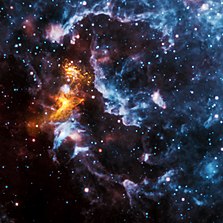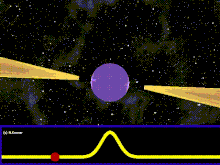

A pulsar (from pulsating radio source)[1][2] is a highly magnetized rotating neutron star that emits beams of electromagnetic radiation out of its magnetic poles.[3] This radiation can be observed only when a beam of emission is pointing toward Earth (similar to the way a lighthouse can be seen only when the light is pointed in the direction of an observer), and is responsible for the pulsed appearance of emission. Neutron stars are very dense and have short, regular rotational periods. This produces a very precise interval between pulses that ranges from milliseconds to seconds for an individual pulsar. Pulsars are one of the candidates for the source of ultra-high-energy cosmic rays. (See also centrifugal mechanism of acceleration.)
Pulsars’ highly regular pulses make them very useful tools for astronomers. For example, observations of a pulsar in a binary neutron star system were used to indirectly confirm the existence of gravitational radiation. The first extrasolar planets were discovered in 1992 around a pulsar, specifically PSR B1257+12. In 1983, certain types of pulsars were detected that, at that time, exceeded the accuracy of atomic clocks in keeping time.[4]
- ^ Nora Roberts; D. R. Lorimer; M. Kramer (2005). Handbook of Pulsar Astronomy (illustrated, herdruk ed.). Cambridge University Press. p. 249. ISBN 9780521828239. Extract of page 249 Archived 2022-11-16 at the Wayback Machine
- ^ "Definition of PULSAR". www.merriam-webster.com. 31 May 2023.
- ^ "NASA's NICER Delivers Best-ever Pulsar Measurements, 1st Surface Map". 11 December 2019.
- ^ Sullivan, Walter (9 February 1983). "Pulsar Termed Most Accurate 'Clock' in Sky". The New York Times. Retrieved 2024-08-30.